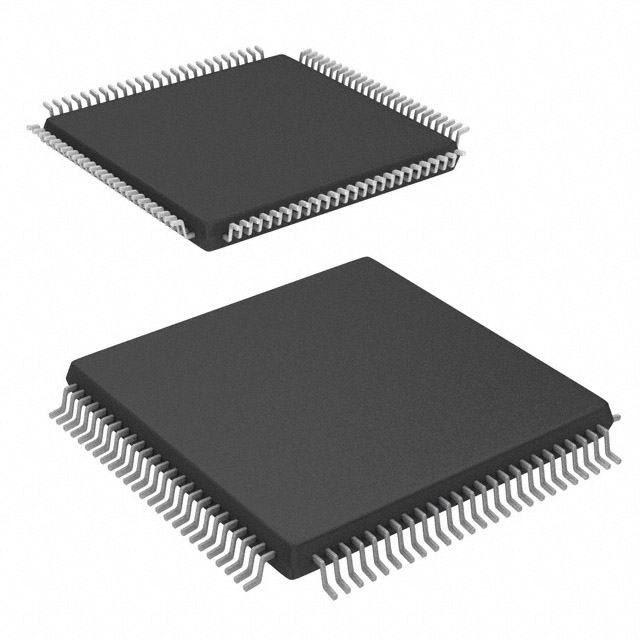Consulte las especificaciones para obtener detalles del producto.

ATXMEGA128A1-AUR
Product Overview
Category
ATXMEGA128A1-AUR belongs to the category of microcontrollers.
Use
It is primarily used for embedded systems and applications that require a high-performance microcontroller.
Characteristics
- High-performance 8/16-bit AVR microcontroller
- Advanced RISC architecture
- Low power consumption
- Large program memory size
- Multiple communication interfaces
- High-speed data transfer capabilities
Package
ATXMEGA128A1-AUR is available in a compact and durable package, suitable for various electronic devices.
Essence
The essence of ATXMEGA128A1-AUR lies in its powerful processing capabilities and versatile features, making it an ideal choice for demanding applications.
Packaging/Quantity
ATXMEGA128A1-AUR is typically packaged in reels or trays, with a quantity of 250 units per reel/tray.
Specifications
- Microcontroller Architecture: AVR
- CPU Speed: Up to 32 MHz
- Flash Memory: 128 KB
- RAM: 8 KB
- EEPROM: 2 KB
- Operating Voltage: 1.6V - 3.6V
- Digital I/O Pins: 32
- Analog Input Channels: 8
- Communication Interfaces: UART, SPI, I2C
- Timers/Counters: 4
- PWM Channels: 8
- ADC Resolution: 12-bit
- Operating Temperature Range: -40°C to +85°C
Detailed Pin Configuration
The ATXMEGA128A1-AUR microcontroller has a total of 64 pins, which are assigned to various functions such as digital I/O, analog inputs, communication interfaces, timers, and more. The detailed pin configuration can be found in the product datasheet.
Functional Features
- High-performance processing capabilities
- Low power consumption modes for energy efficiency
- Advanced communication interfaces for seamless connectivity
- Flexible timers and counters for precise timing operations
- PWM channels for accurate control of analog signals
- Analog-to-Digital Converter (ADC) for precise analog measurements
Advantages and Disadvantages
Advantages
- Powerful processing capabilities
- Versatile communication interfaces
- Low power consumption
- Ample program memory size
- Precise analog measurements
Disadvantages
- Relatively higher cost compared to some other microcontrollers
- Steeper learning curve for beginners
Working Principles
ATXMEGA128A1-AUR operates based on the AVR architecture, utilizing a combination of hardware and software to execute instructions. It follows a RISC (Reduced Instruction Set Computer) design, which allows for efficient execution of instructions and optimized performance.
Detailed Application Field Plans
ATXMEGA128A1-AUR finds applications in various fields, including but not limited to: - Industrial automation - Consumer electronics - Automotive systems - Medical devices - Internet of Things (IoT) - Robotics
Alternative Models
There are several alternative models available that offer similar functionalities to ATXMEGA128A1-AUR. Some notable alternatives include: - ATmega128A - PIC32MX795F512L - STM32F407VG
These alternative models can be considered based on specific project requirements and compatibility with existing systems.
In conclusion, ATXMEGA128A1-AUR is a high-performance microcontroller with versatile features, making it suitable for a wide range of applications. Its powerful processing capabilities, low power consumption, and flexible communication interfaces make it an ideal choice for demanding embedded systems.
Enumere 10 preguntas y respuestas comunes relacionadas con la aplicación de ATXMEGA128A1-AUR en soluciones técnicas
Sure! Here are 10 common questions and answers related to the application of ATXMEGA128A1-AUR in technical solutions:
Q1: What is the ATXMEGA128A1-AUR? A1: The ATXMEGA128A1-AUR is a microcontroller from Microchip's XMEGA family, featuring 128KB of flash memory, 8KB of SRAM, and various peripherals.
Q2: What are the key features of the ATXMEGA128A1-AUR? A2: Some key features include high-performance CPU, multiple communication interfaces (UART, SPI, I2C), analog-to-digital converters, timers/counters, and a wide operating voltage range.
Q3: What applications can the ATXMEGA128A1-AUR be used for? A3: The ATXMEGA128A1-AUR is suitable for a wide range of applications including industrial automation, consumer electronics, smart energy systems, and automotive solutions.
Q4: How can I program the ATXMEGA128A1-AUR? A4: The microcontroller can be programmed using various development tools such as Atmel Studio, MPLAB X IDE, or other compatible Integrated Development Environments (IDEs).
Q5: Can I use the ATXMEGA128A1-AUR for low-power applications? A5: Yes, the ATXMEGA128A1-AUR offers power-saving features like sleep modes, event system, and real-time clock (RTC) that make it suitable for low-power applications.
Q6: Does the ATXMEGA128A1-AUR support external memory expansion? A6: Yes, the microcontroller supports external memory expansion through its External Bus Interface (EBI), allowing you to connect additional RAM, ROM, or other memory devices.
Q7: Can I interface the ATXMEGA128A1-AUR with sensors? A7: Absolutely! The microcontroller has built-in analog-to-digital converters (ADCs) and digital I/O pins that can be used to interface with various sensors such as temperature, pressure, or motion sensors.
Q8: What communication interfaces are available on the ATXMEGA128A1-AUR? A8: The microcontroller provides UART, SPI, and I2C interfaces for serial communication with other devices or peripherals.
Q9: Is the ATXMEGA128A1-AUR suitable for real-time applications? A9: Yes, the microcontroller offers multiple timers/counters and a flexible event system, making it suitable for real-time applications that require precise timing and synchronization.
Q10: Are there any development boards available for the ATXMEGA128A1-AUR? A10: Yes, Microchip offers development boards like Xplained Pro series that support the ATXMEGA128A1-AUR, providing an easy way to prototype and evaluate your technical solutions.
Please note that these answers are general and may vary depending on specific requirements and use cases.

